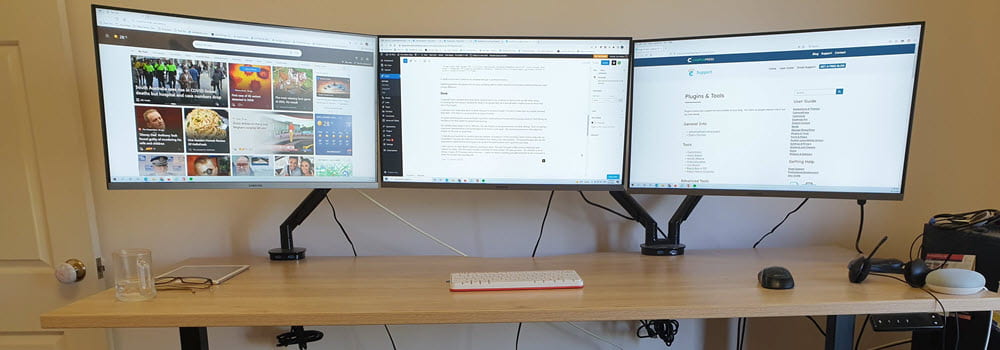This is a joint post between Chris Betcher and myself on Flickr and Picasa, and has been cross posted on each of our blogs. Please note that we had written different sections and apologies but “I” may mean Chris or me (Sue).
Let’s start with Chris’s section and background on the post’s origin
After spending some time yesterday migrating Linda’s (Chris’s girlfriend) entire photo collection (well, most of it… did I mention that regular backup is very important?) into Google’s Picasa photo management application and then giving her a bit of a tutorial in how to use it tonight, she asked the next obvious question… how do I put some of these photos onto Flickr? A good question. After all, Flickr is without a doubt the best online photo sharing website around. With amazing tools and options, an incredible online community for sharing and learning from each other, and a huge array of APIs that enable Flickr to work with a range of different online and offline services, the decision to use Flickr as your online photo storage tool of choice is a bit of a no-brainer.
However, on the desktop it’s a different story. Flickr is purely a Web2.0 service, and there is no local desktop component offered with it. This means that while Flickr is wonderful at managing your photos online, when it comes to dealing with the photos stored on your hard drive the only real options you have is whatever tools are already on your computer. If you have a Mac, iPhoto does a great job of photo management. It’s free and comes with every Mac. If you are more serious you can always look at Adobe’s Lightroom or Apple’s Aperture, but these are quite expensive applications. On the Windows side, there are probably dozens of “photo management” applications but most of them are pretty awful, and some are also expensive. Most people just settle for managing their photos directly in Windows Explorer which is an average solution at best.
Using Picasa for your offline photo management
Enter Picasa from Google. Picasa is a wonderful free piece of photo management software and lets you sort, arrange, adjust, crop, rename and generally manage your photos on your computer. It really is an incredibly sophisticated yet simple tool for photographers and the price tag can’t be beaten…. you can’t do much better than free. It is available for Windows only, which makes perfect sense since it essentially does most of what iPhoto already does on the Mac. As well as the desktop app, there is also a “Flickr-like” online photo service from Google called Picasaweb. I say “Flickr-like”, because although it lets you store your photos online it lacks the same community and API sharing that makes Flickr so compelling. If you’re serious about photos online Picasaweb could be a little disappointing. However, being from the Google stable of products, there is some common functionality for exporting photos directly from Picasa on your computer to Picasaweb on the net, which is a nice touch.
The trouble is that while Picasa may be an obvious best choice for local photo management, Flickr is the obvious best choice for online photo management. It would be nice to have the option to manage your photos locally with Picasa and then send your best shots up to Flickr to share with the world. Nice, except that Picasa is owned by Google and Flickr is owned by Yahoo!, and when companies are in direct head to head battle like Yahoo! and Google are, the last thing you want to do is anything that promotes your competition. This is unfortunate, since the losers in that battle are you and I, the consumers. We just want to manage our photos using the two tools we like, but it’s not as quite as straightforward as that.
Connecting via Twitter
Talk about synchronicity. As I was pondering this question tonight, the exact same question floated through my Twitter feed. Mrs_Banjer , sujokat and Sue (dswaters) were discussing the very same issue – how to manage your photos on and offline, what service to use, how to integrate them, and essentially they were tweeting on the very same things I was thinking about. One thing led to another, so via Twitter we discussed, chatted, talked and shared links. We pontificated on the pros and cons of Flickr versus Picasa. This is just one example of the power of an always-on personal learning network. Eventually though, I felt I needed to clarify a point in the discussion so rather than overTweet to the world, I Skyped Sue Waters in Perth and chatted about it directly. While we were talking a tweet came through from sujokat asking “someone do a blog on this please this is fabulous but all too quick for me to take it all in”. Sue and I decided that we’d do that… write a post about the pros and cons of Picasa and Flickr, but we’d do it as a joint post. So this is being written in Google Docs and is a collaborative effort between Sue and I… over to you Sue.
Now for My (Sue’s) Thoughts On Picasa vs Flickr
One of the best aspects of Twitter connectivity is the challenging of your thoughts, beliefs and making you really think; often about issues you had not considered. This was definitely the case with Picasa vs Flickr. I have rarely used Picasa as Window Explorer and Picture Manager have been adequate for my needs but really into Flickr. In all fairness to Picasa more likely that I have not spent enough time exploring the virtues of Picasa — it did take me 12 months to realise the benefits of Flickr. So my homework for the next few days is to throughly road test Picasa and report back to ensure I have done my usual through research.
It is definitely beneficial to import photos from your camera directly into Picasa because it means you don’t import multiple copies of the same photo.
Uploading to Flickr
For Mac users, there are several options for getting photos to Flickr. As iPhoto is a standard application found on every Mac it is a much simpler proposition for developers to create APIs that hook directly between iPhoto and Flickr, so there tends to be a number of uploading tools available, the best known of which is Flickr Uploadr. As well as the Flickr Uploader, there are free tools like FFXporter that plug directly into iPhotos Export option to offer direct Flickr integration. Another option is to use Flock as your web broswer… Flock has Flickr uploading tools built right in.
For Windows users who like Picasa as their photo management tool, uploading images to Flickr from Picasa is also a relatively simple process, even if not quite as obvious or integrated as that enjoyed by Mac users. Just download and install Flickr Uploadr on your desktop, open the Flickr Uploader and Picasa windows alongside each other, then drag and drop the images from Picasa library onto the Flickr Uploader. Simple!
Final Thoughts
Also worth checking out David Jake’s thorough information on Flickr (thanks sukojat for the link) and Philip Nichols’s guide to Picasa.
Besides learning a lot more about Picasa it has been amazing collaborating writing a post; using Google Documents, Twitter and Skype — and Chris has a great writing style (jealous!!!).
Chris and I would love to learn more about how you manage your photos.
What are your thoughts? Do you use an offline photo management software? What features do you like about the software you use? Do you share your photos online at Flickr or do you use another photosharing website? And if so, which one and why?
Please take this opportunity to drop past Chris’s post and leave some tips for him as well.
And if you’re enjoying this blog, please consider subscribing for free.




Leave a comment